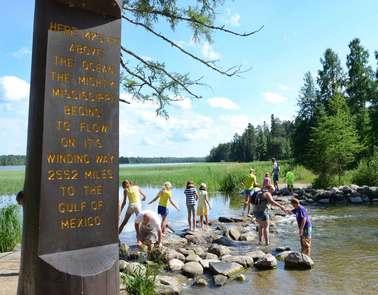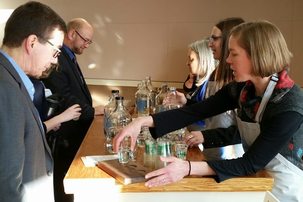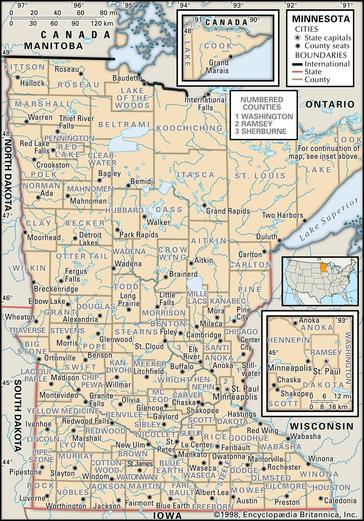February 2017
 At the Environmental Congress Feb. 3 Gov. Mark Dayton announced a new “25 by ‘25” water quality goal, to improve Minnesota’s
water quality 25 percent by 2025. Without additional action, the quality of
Minnesota’s waters is expected to improve only 6 to 8 percent by 2034. If
approved by the Legislature, Gov. Dayton’s proposed new goal would engage
local governments, farmers, scientists, environmental groups, and business
leaders in a collaborative effort to address Minnesota’s water quality
challenges. News release.
Gov. Dayton has declared a “Year of Water Action” urging all Minnesotans
to rethink water usage in daily life, make informed consumer choices, and talk
to others about clean water protection and preservation. Last week, Gov. Dayton convened a Town Hall Water Summit
in Morris
to discuss water challenges and solutions in Greater Minnesota. More
information about all of Gov. Dayton’s proposed investments in clean,
affordable water can be found
here. Photo: MPCA Commissioner John Linc Stine (second from right) looks on as Gov. Dayton talks with reporters at the Environmental Congress.
|
 Public workshops on the on the Minnesota
River Valley Master Plan are scheduled for Feb. 15 and 16 in Olivia and Redwood Falls. The Dept. of Natural Resources is
collaborating with Redwood and Renville counties as they seek input for the
Minnesota River Recreation Area Master Plan. The master plan will leverage
natural, recreational, cultural, historical and agricultural assets located
within two miles either side of the Minnesota River in the two counties.
The first public
workshop sessions were completed in September. Now the public has another
chance to weigh in on the refined plans. Public workshops are planned for
6-8 p.m., Feb. 15 and 16.
- Wednesday, Feb.
15: Renville County
Government Offices, 105 South 5th
St., Olivia., room. 117.
- Thursday, Feb. 16: Redwood Falls
Community Center, 901 E. Cook St.,
Redwood Falls, room 2.
Back to top
|
 The upper Mississippi River is in great shape until
pollutants flow in from farmland and cities. By the time it reaches
Minneapolis, it no longer meets water quality standards for river life and
recreation.
Results from a new study by the Minnesota Pollution Control Agency
(MPCA) highlight the need to protect wetlands and forests in the iconic river’s
northern areas while taking action to curb pollution in its southern reaches. Report overview.
While the upper reaches need
protection to keep the river healthy, the lower reaches need large-scale
changes to reduce pollutants. After the Crow River flows into the Mississippi,
phosphorus and nitrate pollution double in levels. The Crow drains a heavily
farmed area and makes up about 15% of the total land area draining to the upper
Mississippi in Minnesota.
“Thanks to groups
like the Crow River Organization of Water, watershed districts, and soil and
water conservation districts, work has already started to curb this pollution.
But we all need to do more. We need more buffers, better use of fertilizer and
manure, and more conservation on farmland and urban land,” said Dana
Vanderbosch, manager of lake and stream monitoring for the MPCA.
As part of assessing the health
of major watersheds across Minnesota, the MPCA studied the 510 miles of the
upper Mississippi from Lake Itasca to St. Anthony Falls in Minneapolis.
Scientists measured levels of pollutants such as sediment, nutrients, bacteria
and mercury. They also studied populations of fish and other aquatic life such
as insects. Using data from nearly 200 monitoring stations along the upper
Mississippi, from many partners and spanning 10 years, the agency determined
whether several sections of the river met water quality standards.
For more information, visit the
study webpage at www.pca.state.mn.us/upper-miss.
Back to top
|
 More than 500 people attended the Governor's Water Summit Jan. 27 at the University of Minnesota-Morris. The summit focused public attention on the serious challenges facing Minnesota’s water supplies — in both rural and urban areas of the state — and continued statewide dialogue around steps that must be taken to address those challenges. It brought together local government leaders, farmers, students, environmentalists, businesses, and a wide variety of other stakeholders. The program included two panel discussions:
Panel 1: The Food and Water Nexus: Water is essential to food production, but what is the impact of agricultural activities on water quality and public health? Are farmers taking on risk by making continuous improvements that minimize impacts on water? What is the role and responsibility of private sector industry? What kinds of support do farmers need to make changes?
Panel 2: The Economic Importance and Burden of Water for Communities: What are the challenges facing local communities and watershed management plans? What innovative solutions and best practices to improve water quality are being cultivated in Greater Minnesota?
The summit was the second large public forum during Gov. Dayton’s Year of Water Action. In February 2016, Governor Dayton convened the first ever Water Summit to bring attention to the challenges Minnesota faces to protect and improve water quality across the state. More than 1,000 Minnesotans participated in the event – the first of its kind in the nation. Read key findings from Governor Dayton’s 2016 Water Summit here.
For more information about Governor Dayton’s Year of Water Action and what individuals, businesses and communities can do to improve the quality of Minnesota’s most precious resource, visit mn.gov/governor/wateraction.
Morris Sun-Tribune: Dayton, speakers address water quality in Morris. Photo: The summit social hour featured a 'water bar' of samples from several municipalities.
Back to top
|
The 9th
annual Crop Nutrient Management Conference, will be
held on Feb. 7, from 9 a.m.-4 p.m. at River’s Edge Convention Center in St.
Cloud. The conference program will focus on nitrogen and phosphorus management
with significant emphasis on water quality and economics.
In addition to economics and crop production, nutrient
management can also have a major benefit for water quality. It is a major part
of Minnesota’s Nutrient Reduction Strategy, which was
introduced at the 2014 Nutrient Management conference in Mankato. More
recently, cover crops and building soil health are receiving greater attention,
both for water quality and production benefits. Photo: Cover crop in Renville County soybeans.
The conference is hosted by the Minnesota Agricultural Water
Resource Center (MAWRC) with primary sponsorship from the Minnesota Department
of Agriculture. The conference will highlight recent advances in effective and
economical nutrient management presented by University of Minnesota researchers,
fertilizer industry experts and state agency officials.
Farmers, crop advisors and other nutrient management
professionals are encouraged and invited to attend. The ongoing importance of
efficient use of applied crop nutrients relating to farm profitability and food
production economics combines with growing interest in the environment.
Back to top
The Minnesota Pollution Control Agency has extended the application period for federal Clean Water Act Section 319 grant funds to Feb. 17, 2017 at 4:30 p.m. Eligible projects will reduce nonpoint source pollution in Minnesota’s lakes, rivers, and streams. Eligibility criteria language has been clarified in the request for grant application and is posted on the MPCA website. The MPCA anticipates about $2.5 million will be available this year, contingent upon Congressional appropriation. Eligible applicants must have a TMDL study, TMDL implementation plan, and WRAPS approved by the MPCA by Dec. 31, 2016. No nonpoint source development, education or applied research projects (DER) projects will be funded this year. Changes this year include a minimum grant request of $50,000. Grant funds are limited and MPCA urges proposers to request only those funds needed to complete a project by Aug. 31, 2021.
Back to top
 The third annual U of M Nitrogen Conference will be held Thursday, Feb. 16 at the Verizon Wireless Center in Mankato. University and other experts will present research-based information on crop production and environmental stewardship for crop producers and other ag professionals. Certified crop advisers will be able to earn CEUs in soil and water nutrient management. Topics include: Nitrogen management tools, nitrates in tile drainage and ground water, nitrogen cycle, and an update on the Des Moines Water Works court case. Register online.
Back to top
|
 A retirement open house is scheduled Wednesday, Feb. 8 for long-time MPCA staff member, Wayne Anderson. It will be from 1:30 p.m. to 4 p.m. in the public lobby of the DNR headquarters on Lafayette Road in St. Paul. Anderson began his career at the MPCA in 1973 as one of only two people working on the early stages of the feedlot program. He helped launch the 'county feedlot program', in which 51 counties today partner with the state to provide service at the county level. Back then, feedlots received a 'certificate of compliance' if their operations met requirements for protecting water quality, many of which bore his signature.
In the 1980s as the MPCA began moving beyond industrial pollution issues, Anderson helped with the development of a non-point source pollution program. Starting in the 1990s he worked on Minnesota River issues and the Gulf of Mexico hypoxia task force. For about eight years he was designated the MPCA's ag liaison. More recently, he helped with the statewide Nutrient Reduction Strategy, related to the hypoxia task force. Wayne plans to stay active in support for the University of Minnesota through the Department of Bioproducts and Biosystems Engineering and professional organizations such as the Soil and Water Conservation Society.
Back to top
|
U of M Extension launches new soil management and health website
Balancing the economic and environmental benefits of soil management strategies can be a challenge. U of M Extension Crops team has launched a website that offers research-based resources to help producers improve soil and crop productivity, while minimizing environmental risks. The website, Soil management and health, features articles and videos in three primary sections:
- Soil properties – includes descriptions of Minnesota soils and how they are formed, the importance of soil structure and the roles of organic matter and soil biology in building structure.
- Tillage and soil management – includes resources for reducing soil compaction and erosion, managing crop residue, and evaluating tillage systems.
- Cover crops – includes discussions on the benefits of cover crops and resources for selecting, establishing and maintaining them.
- Soil fertility - provides a direct link to the U of M Extension Nutrient management website, which houses current crop fertilizer suggestions and data from the University of Minnesota.
The website also includes presentations, an A to Z library to find topics more easily, and links to other University soil websites.
Stormwater funding strategies workshop and webinar Feb. 6
A workshop is scheduled for 1-4:30 p.m., Feb. 6 at the MPCA St. Paul office, 520 Lafayette Rd. N. It will be an interactive forum on the wide range of financial
assistance programs for projects that improve stormwater management. Program staff
will discuss application deadlines, annual funding cycles and other program
requirements to seek funding for needed projects. Past funding recipients
will share practical tips and discuss their experience in seeking and
successfully being awarded funds.
Programs participating include
State Revolving Fund, Point Source Implementation Grants, Clean Water
Partnership, EPA 319 non-point, Met Council, Clean Water Fund (including
projects and practices and accelerated implementation grants). Anna Henderson
from the Governor's office will kick off the event and Michael Thompson from
the City of Maplewood will give a presentation on Asset Management. To attend the webinar, go
to: https://mpca.webex.com/mpca/onstage/g.php?MTID=eea04abfca92d610f8a71918cc7891d02 . There will be no
call in number. Audio will be through your computer (headphones,
speakers, etc.) The webinar will be recorded and will be posted in the
Stormwater Manual. For additional information,
please contact MPCA staff- Anne Gelbmann at 651-757-2384 or anne.gelbmann@state.mn.us; or Bill
Dunn (651-757-2324) or bill.dunn@state.mn.us.
The federal Section
319 funding round is currently open; application deadline is Friday,
Feb.y 3. his grant program provides funding and technical
assistance to groups and individuals who work with citizens to develop locally
based solutions to nonpoint source pollution.
Hawk Creek Watershed Project annual meeting Feb. 22
The 15th annual Hawk Creek Watershed Project Information and Appreciation Meeting is set for Wednesday,
Feb. 22. Registration opens at 8:30 a.m. Due to construction, the meeting location has
changed for this year and will be held at the Renville Community Center. Speakers include
Brad Carlson with the U of M Extension on nitrates in drainage water in Minnesota,
Amanda Strommer from MDH on our groundwater and its importance as our drinking
water source, and Liz Stahl from U of M Extension on cover crops, looking
specifically at herbicides and weed control. If you’d like to attend and stay for lunch, please RSVP to the HCWP office: 320-523-3666, e-mail: heidi@hawkcreekwatershed.org.
Seven Mile Creek Watershed manager job opening
Great River
Greening is seeking a Seven Mile Creek Watershed manager based in the Nicollet Soil and Water Conservation District (SWCD) office in St. Peter. A nonprofit conservation organization based in St.
Paul, Great River Greening's mission is to secure the legacy of Minnesota lands and
waters through community restoration, stewardship and partnerships. Since 1999, Great River Greening has restored more than 15,000 acres of
natural habitat state-wide, while engaging more than 39,000 volunteers in the
process. It's geographic scope has expanded to: 1) Twin Cities
Metro; 2) Anoka Sandplain; 3) Minnesota River, and 4) Minnesota’s Wild and
Scenic Rivers. The Watershed Manager will work in partnership with Nicollet SWCD and NRCS staff as a member of the local conservation team in conducting outreach to landowners within the Seven Mile Creek watershed and surrounding watersheds. For more information, click here to go to the job posting.
Back to top
The Dept. of Agriculture is requesting
proposals for research to quantify the effectiveness of agricultural
conservation practices related to impaired waters and for development and
evaluation of best management practices to protect and restore water resources.
Proposals must be received no later than 3 p.m. Feb. 10. Additional information regarding the Request for Proposals, including research priorities, is available in the Jan. 3 State Register (see page 846 or 22)
Proposals should quantify agricultural conservation practice
effectiveness related to nutrient source reduction, off-site movement, and
treatments. Proposals should focus on the water
quality effects of individual conservation practices and/or the cumulative
effects of multiple conservation practices. Proposals must include a cost
effectiveness component, as well as an education and outreach plan to
benefit Minnesota residents.
To request proposal instructions and to receive
application materials, please e-mail for the full RFP, which will be sent free
of charge to interested parties. Contact: Heidi Peterson, Impaired Waters Technical Coordinator, 625 Robert Street North, St. Paul, MN 55155-2538, Email: Heidi.Peterson@state.mn.us
Back to top
 The Minnesota Farm Bureau Federation partnered with the Minnesota Agricultural Water Resource Center to create profiles of every county of their land and water resources. Fact sheets have been posted on the Farm Bureau web page. Farmers and landowners are encouraged to use them as a resource when discussing the importance of farming to local communities: "Study the information for your county to begin thinking about the importance of farms and water in your area, and how you can share your farm story with others."
Points to consider include:
- What are you doing on your farm to address natural resource concerns?
- What role does your farm play in helping maintain a healthy watershed?
- What is the importance of good agronomic practices as part of your overall conservation plan?
Back to top
|
|